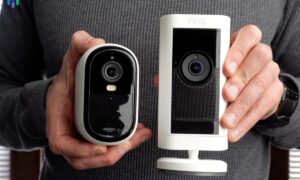Installing security cameras at your home or business for safety is crucial. But if not done right, the cameras might not work like they should. Avoid these common mistakes when you install security cameras:
Mistake 1: Wrong Camera Spots
Choosing poor camera locations creates blind spots that cameras can’t cover.
- Putting cameras too high or too low impacts how much the camera can view. The best height is 8-10 ft, tilted down 15-30 degrees.
- Failing to aim cameras at key areas can leave vulnerabilities that intruders might exploit. Check the whole area first to find all the ways in.
- Places where cameras face windows or bright lights make it hard to see clearly. Ensure consistent lighting throughout the area.
Tip: Before installation, walk through the area and use the cameras to test different views to find the optimal spots.
Mistake 2: Not Enough Equipment
Choosing inexpensive equipment can compromise security:
- Low-quality cameras make blurry footage that misses details. Use at least 1080p HD cameras that can see at night.
- Wireless cameras have issues if WiFi doesn’t reach well everywhere. Get PoE (Power over Ethernet) cameras on strong networks.
- Recorders without large hard drives quickly overwrite old recordings. Get 2TB+ drives to keep 30 days of video.
| If You Encounter This Camera Issue | Do This |
| Blurry/distorted video | consider using 1080p or 4K HD cameras |
| Spotty wireless video | consider switching to wired PoE cameras |
| Can’t store a large amount of video | consider upgrading to 2TB+ recorder drives. |
Mistake 3: Network Issues
The network connecting security cameras is crucial for proper functionality. But network problems make cameras go down:
- Using routers not designed for HD cameras can result in video interruptions. For best results, use strong AC1900 or AX3000 routers with quad-core chips, external antennas, and multiple LAN ports. These give enough bandwidth for multiple camera feeds.
- Cameras in WiFi dead zones with no signal lead to frozen video. Check coverage everywhere with WiFi scanner apps, and fix weak spots.
- Keeping cameras on your normal network leaves them open to hacking. Ensure that cameras and recorders are on separate networks with access rules set up on managed business switches. Assign a separate WiFi name and settings to this network.
Tip: Consult IT experts to design a robust camera network that prevents crashes and hacking. Implement failover links between the internet and switches.
Mistake 4: Bad Spot for Recorders
Poorly chosen spots for NVR/DVR make them difficult to access.
- Placing recorders in tight closets makes it difficult to replace hard drives. Select convenient and easily accessible locations instead.
- Dusty, humid, hot spots risks equipment failure. A controlled climate is necessary.
Out-of-sight recorders can be tampered with. Mount them visibly near the cameras.
Tip: Choose open, climate-controlled locations that are visible to the cameras.
Mistake 5: Forgetting Safety Steps
Neglecting login security poses a serious risk of camera hacking.
- Failure to document default admin logins can complicate device resets in the future. Safely note them down after changing defaults.
- Leaving default passwords lets hackers use common factory ones. Change immediately using password tools.
- Weak passwords like “12345” are easy to crack. Make 15+ letter passwords with numbers, and symbols.
- If you skip two-factor authentication, leaked passwords can provide unauthorized access. Turn on 2FA to improve safety.
- Shared logins mean more chances for leakage over time. Give each user their login.
Tip: Generate long, unique, random passwords for each user/device and store them securely offline. Restrict camera access to authorized security teams.
An even better approach is to use centralized servers to manage all passwords. Auto reset passwords, require signing in to access cameras.
Mistake 6: No Testing Run
Skipping testing can lead to discovering issues only after installation. The market for security cameras has been growing as shown in the chart below:
Data Source: Markets and Markets
Selecting the right security camera with necessary features is essential for your needs. Let’s explore common mistakes when choosing a security camera:
- Failure to check the hardware initially can reveal damaged components requiring replacements.
- Skipping connection tests may uncover network gaps.
- Not checking picture quality in different lighting could show lens problems needing adjustment.
Efficiently save time and effort by conducting comprehensive testing before final installation.
Mistake 7: Focusing Only on Cost
Opting for the cheapest option can lead to issues:
- Inexpensive hardware often lacks the necessary capabilities.
- Expanding low-cost systems ends up costing more than a good initial investment.
- DIY may appear cost-effective, but it demands significant expertise for complete setup.
Choose reputable brands and qualified installers rather than solely focusing on the cheapest option. Investing more initially can lead to long-term savings.
Mistake 8: Not Considering Scalability
Failure to plan for business growth can hinder capacity:
- Purchasing the minimum number of cameras today can result in coverage gaps as your needs expand. Calculate 20-30% extra cameras up front.
- Getting a recorder with few available hard drive bays prevents adding storage. Ensure there are 6 or more empty drive slots for future growth.
- Routing all network cables to a small 5/8 port PoE switch can hinder the addition of devices in the future. Deploying larger 24/48 port switches leaves room to scale up.
Incorporate a scalability margin during the initial rollout to reduce future complications.
Mistake 9: Skipping Maintenance & Upkeep
Failure to perform regular inspections can lead to breakdowns:
- Assuming that installation concludes all requirements overlooks the need for eventual servicing. Schedule recurring checkups.
- Failure to monitor equipment room conditions can lead to unnoticed climate control failures that impact hardware.
- Neglecting minor lens scratches or cleaning today can lead to completely blocked views later, hampering surveillance.
Maintain lens cleanliness, inspect cabling, and ensure continuous optimal operations through regular preventative walkthroughs.
Mistake 10: Limited Cyber Security Precautions
Ignoring camera network vulnerabilities creates significant gaps:
- Failing to change telnet, SSH and other service credentials from defaults allows attackers easy remote access. Disable or resecure these services completely. Don’t leave backdoors.
- Having no firewall protections lets malware or ransomware spread across the entire camera network by compromising just one device. Deploy enterprise-grade next-gen firewalls to enforce deep packet inspection and block such threats.
- Assuming that obscurity can protect your camera network from adversaries underestimates the capabilities of automated vulnerability scanners, which can eventually discover and exploit devices exposed online without protection. Avoid overlooking these security measures.
Adhere to cybersecurity best practices such as regular firmware updates, penetration testing, VLAN isolation, and firewall deployments to secure the camera network.
Frequently Asked Questions:
- What’s the best height for security cameras?
8-10 ft high, tilted down 15-30 degrees. Gives maximum viewable area.
- Can I use wireless cameras instead of running wires?
Yes, but only if WiFi coverage is solid everywhere. Otherwise prefer wired PoE cameras.
- Is professional installation better than DIY?
Yes. Ensures proper placement, equipment selection, and configurations best suited for your space.
Conclusion
To ensure the smooth installation of effective security cameras that meet your needs, avoid these 10 common mistakes. Take the time to plan suitable camera locations, acquire appropriate equipment, establish a robust camera network, position recorders sensibly, secure accounts rigorously, conduct thorough testing, choose reputable providers, account for future growth, perform regular maintenance, and enhance system security against cyber risks. Making informed investments now can lead to savings in the future.




































